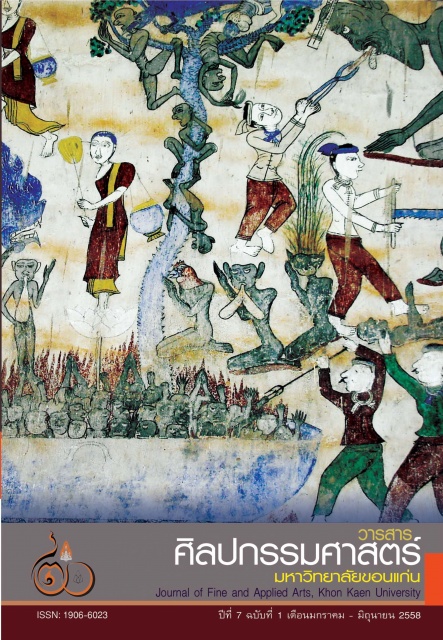พิธีกรรมหลังความตายของชนเผ่าม้ง ในสาธารณรัฐประชาธิปไตยประชาชนลาว: รูปแบบและการเปลี่ยนแปลง ตั้งแต่ปีคริสตศักราช 1975 ถึงปีคริสตศักราช 2012. RITUALS OF DIES IN HMONG IN THE LAO PEOPLE’S DEMOCRATIC REPUBLIC: PATTERN AND CHANGE AFTER 1975 TO 2012.
Main Article Content
บทคัดย่อ
การศึกษาวิจัยเรื่องพิธีกรรมหลังความตายของชนเผ่าม้งในสาธารณรัฐประชาธิปไตยประชาชนลาวครั้งนี้เป็นการวิจัยเชิงคุณภาพ มีวัตถุประสงค์เพื่อ 1) เพื่อศึกษาประวัติความเป็นมาของพิธีกรรมหลังความตายชนเผ่าม้งในสาธารณรัฐประชาธิปไตยประชาชนลาว 2) เพื่อศึกษา รูปแบบ และการเปลี่ยนแปลงพิธีกรรมหลังความตายชนเผ่าม้งในสาธารณรัฐประชาธิปไตยประชาชนลาว ตั้งแต่ปี ค.ศ. 1975 ถึง ปีค.ศ. 2012 โดยทำการเก็บรวบรวมข้อมูลในปี พ.ศ. 2555 ในพื้นที่แขวงหลวงพระบาง แขวงเชียงขวางและนครหลวงเวียงจันทน์ จากกลุ่มตัวอย่าง จำนวน 55 คน ประกอบด้วยผู้รู้ 10 คน ผู้ปฏิบัติ 25 คน และผู้เกี่ยวข้อง 20 คน โดยใช้แบบสำรวจ แบบสังเกต แบบสัมภาษณ์และการสนทนากลุ่ม นำข้อมูลมาศึกษาวิเคราะห์โดยใช้ทฤษฎีประวัติศาสตร์ (Historicalism) ทฤษฎีการแพร่กระจายทางวัฒนธรรม (Diffusionism) ทฤษฎีรูปแบบทางวัฒนธรรม (Configurationism) ทฤษฎีนิเวศวิทยาทางวัฒนธรรม (Cultural Ecology) ทฤษฎีโครงสร้างและหน้าที่นิยม (Structural- Functionalism) ผลการศึกษาพบว่า
ประวัติศาสตร์ของพิธีกรรมหลังความตายของชนเผ่าม้งในสาธารณรัฐประชาธิปไตยประชาชนลาวเริ่มต้นขึ้นในช่วงต้นคริสตวรรษที่ 1800 เมื่อการค้าฝิ่นเจริญรุ่งเรืองขึ้นในสมัยราชอาณาจักรลาวได้ส่งผลต่อจำนวนเครื่องเซ่นสังเวยที่มีมากขึ้น การเปลี่ยนแปลงนี้สามารถสื่อให้เห็นได้ถึงภาวะอำนาจของการเมืองและเศรษฐกิจที่เริ่มเข้ามามีบทบาทในพิธีกรรมและวัฒนธรรมของชนเผ่าม้ง ในยามสงครามการประกอบพิธี มีเพียงการฝังดินแบบง่ายๆ และจุดลำไม้ไผ่ให้เป็นควันก่อนการฝังเพื่อการบูชาศพเท่านั้น ในช่วงระยะจินตนาการใหม่ การผ่อนปรนในด้านวัฒนธรรมได้ส่งผลต่อพิธีกรรมความเชื่อในด้านพิธีกรรมหลังความตายนั้นชนเผ่าม้งซึ่งสามารถที่จะใช้ธรรมเนียมปฏิบัติดั้งเดิมของตนได้อย่างอิสระมากขึ้น ในช่วงปี ค.ศ.2012 นั้นน่าจะเป็นการเปลี่ยนแปลงในด้านเศรษฐกิจ ซึ่งส่งผลต่อองค์ประกอบของพิธีกรรมในด้านวัตถุ
รูปแบบในพิธีกรรมหลังความตายแบบดั้งเดิมนั้นยังคงปรากฏอยู่สืบเนื่องมาจนถึงยุคปัจจุบันคือขั้นตอนของการเตรียมศพ การบูชาศพและการฝังศพ โดยในแขวงหลวงพระบาง แขวงเชียงขวาง และแขวงนครหลวงเวียงจันทน์นั้นมีความคล้ายคลึงกัน ด้านเวลากระบวนการต่างๆในการเตรียมศพจะต้องเสร็จสิ้นภายในหนึ่งวัน การจัดเตรียมสถานที่จะเริ่มตั้งแต่การจัดเตรียมแท่นบูชาบรรพบุรุษซึ่งอยู่ตรงหน้าทางเข้าประตูบ้านและมีการจัดวางเครื่องเซ่นต่างๆไว้ในตำแหน่งที่กำหนด ด้านบุคคล ประกอบไปด้วยคนเตรียมศพ คนจัดเตรียมโลงศพ คนจัดหาเสบียงอาหารสำหรับพิธีศพ คนรับแขกและคนที่จะประกาศข่าวการตาย ด้านวัตถุ ประกอบไปด้วยวัตถุที่อยู่ภายในส่วนโลงศพ และวัตถุที่อยู่ภายนอกส่วนโลงศพ วัตถุที่อยู่ภายในโลงศพ ถูกจัดเตรียมไว้ตั้งแต่ในขั้นของการเตรียมศพ วัตถุที่อยู่นอกโลงศพนั้นจะถูกจัดเตรียมภายหลัง เมื่อมีการใช้กระดาษสาสีขาวหรือผ้าขาวปิดหน้าหิ้งของบรรพบุรุษเสียก่อน เพื่อเป็นการแสดงความเคารพต่อบรรพบุรุษ ด้านการเปลี่ยนแปลง ในช่วงปีคริสตศักราช 1975 มีลักษณะปรากฏสอดคล้องกันอยู่กับเหตุการณ์สำคัญในทางประวัติสาสตร์นั่นคือความเจริญรุ่งเรื่องในช่วงการค้าฝิ่นและความเสื่อมถอยในยุคสงคราม ซึ่งลักษณะของการเปลี่ยนแปลงปรากฏอยู่ในการเปลี่ยนแปลงทางด้านขั้นตอนปฏิบัติ การเปลี่ยนแปลงทางด้านบุคคลและการเปลี่ยนแปลงทางด้านวัตถุ ในช่วงระยะยุคจินตนาการใหม่มีการเปลี่ยนแปลงทางด้านสถานที่ในการฝังศพที่มีการจัดสรรที่ฝังศพให้โดยรัฐและด้านวัตถุ คือเครื่องเซ่นที่ปรากฏถึงการใช้น้ำอัดลมเข้ามาเป็นส่วนหนึ่งในเครื่องเซ่นด้วย ในยุคปัจจุบันปรากฏถึงการเปลี่ยนแปลงทางด้านรูปแบบการฝังศพและวัตถุเป็นหลักโดยเฉพาะอย่างยิ่งนั้นก็คือเบียร์ลาวซึ่งได้กลายมาเป็นเครื่องเซ่นชนิดใหม่ที่เข้ามามีบทบาทสำคัญในพิธีกรรมหลังการตายของชนเผ่าม้ง
The objective of this qualitative research “ The Death Ritual of Hmong in The Lao People’s Democratic Republic “ are 1) to study the history of the death ritual of Hmong in The Lao People‘s Democratic Republic. 2 ) to study the pattern and change of The death ritual of Hmong in The Lao People‘s Democratic Republic From 1975 A.D. to 2012 A.D. by collecting data in the year of 2012 A.D., the focus area are Luang Prabang, Xiankhoang and Vientian prefecture. The data of samples come from 55 people including the experts 10 people. The operators 25 people and the involved people 20 people. The data from questionnaire , observation , interview and group discussion are researched by Theory of Historicalism , Diffusionism , Configutationsism ,culture Ecology and Structural-functionalism , The finding revealed the following:
Histories of the death ritual of Hmong in The Lao People’s Democratic Republic started in the 18th century with the opium trade which flourished in The Lao Kingdom and they have an effect to increase of oblation. This change is shown by the policy and economy that have a role in rite and culture of Hmong. In the ceremony, Juliette is a simple land and the bamboo a day before the funeral to worship only. During imagined looseness in culture does not affect the rites, rituals, belief in death of Hmong, who are able to practice their traditional used more freely. In 2012 is expected to change in the economy which will affect the elements of ritual objects.
Patterns in the traditional rituals of death still exist due to the current generation is the process of preparing a funeral. Worship,funeraland burialIn LuangPrabang, Xiangkhoang and Vientiane are similarities of Processof preparingthe corpsemust be completedwithin one day. Prepare the site to start from the provision of the ancestral altar in front of the door of the house and have offerings in preparation. For the human, withthefuneralarrangementspreparethecoffintheprovision for afuneral.thereception and the people to announcethe death. Forobjective Each of theobjects insidethecoffin.And objectsoutsidethe coffin. Objects insidea coffinwill bepreparedsince thepreparationof thecorpse.Objectsoutsidethe coffinwaspreparedlaterwithwhitepaperor white clothoff theledge ofhis ancestors,In order toshow respect totheir ancestors.
The changes in 1975 areconsistentwithan important historical eventthat isflourishingin theopium tradeand the declinein the postwar era. Thenatures of the changes appearto changetheprocedures. Change the human and change the subject. In the new era of imagination To change the place of burial. Are allocated at the funeral by the government. Theobject istousesoft drinkofferingsthat appeartobe part oftheofferings. In modern times they appear to change the form of burial and its main object. Especially Beer Lao, which became the new offering that took a major role in the rituals after death of Hmong.
Article Details
เนื้อหาและข้อมูลในบทความที่ลงตีพิมพ์ในวารสารคณะศิลปกรรมศาสตร์ มหาวิทยาลัยขอนแก่น ถือเป็นความคิดเห็นและความรับผิดชอบของผู้เขียนบทความโดยตรง ซึ่งกองบรรณาธิการไม่จำเป็นต้องเห็นด้วย หรือร่วมรับผิดชอบใด ๆ
บทความ ข้อมูล เนื้อหา รูปภาพ ฯลฯ ที่ได้รับการตีพิมพ์ในวารสารคณะศิลปกรรมศาสตร์ มหาวิทยาลัยขอนแก่น ถือเป็นลิขสิทธิ์ของวารสารคณะศิลปกรรมศาสตร์ มหาวิทยาลัยขอนแก่น หากบุคคลหรือหน่วยงานใดต้องการนำทั้งหมดหรือส่วนหนึ่งส่วนใดไปเผยแพร่ต่อหรือเพื่อกระทำการใด ๆ จะต้องได้รับอนุญาตเป็นลายลักอักษรจากวารสารคณะศิลปกรรมศาสตร์ มหาวิทยาลัยขอนแก่น ก่อนเท่านั้น


